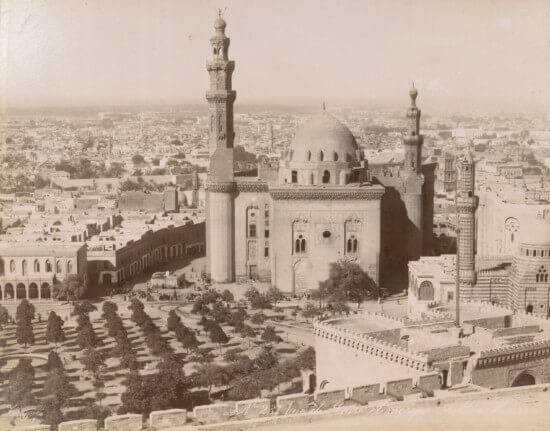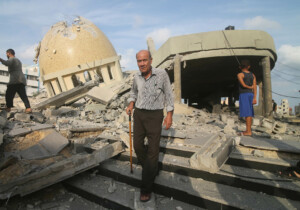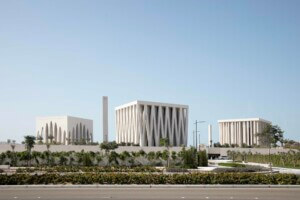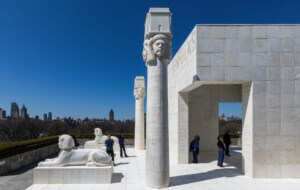Built from 1356 to 1363, the Sultan Hassan Mosque is among Cairo’s greatest monuments. Its scale is exceptional and makes it unique; mosques in the city before, and for centuries after, were not about scale, but rather about the bodily experience of space. What makes Sultan Hassan special to worshippers and visitors is that it manages, despite its scale, to maintain the spatial qualities of a spiritual experience: Its arrangement of spaces unfolds from the entrance to its courtyard surrounded by four soaring iwans, deep niches where prayer takes place. What’s valuable is the way sound echoes, the way light animates the various spaces with precision, the interplay of lightness and darkness, and the small-scale transitional spaces leading to large open ones. The mosque still functions as it was originally intended. Long before—and likely long after—a carbon-based economy, the mosque could operate with no to minimal energy consumption. Oil lamps made of enameled glass that once illuminated the spaces in the night have been replaced with electric light bulbs, yet its energy bill is likely less than that of the average American suburban home.
About 50 miles away and just over an hour’s drive on the immense Cairo Ring Road, Masjid Misr (Egypt Mosque) is among the Middle East’s largest mosques and one of the first buildings completed in the New Administrative Capital under construction in the desert. Its purpose is primarily to house new ministry buildings, a business district including Africa’s tallest skyscraper, gated American-style suburbs, and a planned “green river” bisecting the desert city, a simulacrum of the Nile River, along which Cairo evolved over the millennia it has been Egypt’s capital. The new mosque shares none of the spatial qualities of the Sultan Hassan; it is an energy-guzzling edifice filled with lights, and its enormous interior relies on air-conditioning. The building sits above a podium that houses an Islamic center and a shopping mall–like parking lot for the over 100,000 worshippers needed to fill the space to park their petroleum-burning vehicles. This is not a city made for walking.
Architecturally, the mosque is not innovative, nor does it take Cairo’s historical architecture as a point of reference. Rather, it combines a pastiche of aesthetic elements drawn randomly from the long history of Islamic architecture, best exemplified in the Sheikh Zayed Mosque, built in Abu Dhabi in 2007. The new city (with its major mosque) not only turns its back to Cairo but looks toward the relatively new emirates of the Gulf, where a carbon-based economy (and construction trends) was given a new life through political alliance with Western corporations interested in resource extraction. In this new center, architecture is secondary to the making of such buildings, which become hollow signifiers and spectacles made with a media economy based on Instagram in mind. Long after Instagram is gone and when the lights go out as the planet runs out of energy to burn, which of the two mosques, Sultan Hassan or Masjid Misr, will prove timeless?

Throughout its long history, Egypt has had many capitals: Memphis, Thebes, Tell el-Amarna, Alexandria, and Cairo, founded in 969 and the country’s capital since. While an idea for a new administrative capital was on the table in the 1950s, the project turned into an extension of the existing city with a set of new government buildings to absorb the growing government, the country’s biggest employer at the time. Egypt’s New Administrative Capital was first announced in 2015. Initial renderings were proffered by the international firm Skidmore, Owings & Merrill (SOM), which designed the world’s tallest tower, the Burj Khalifa, completed in 2010 in Dubai, and has enriched its portfolio with numerous projects across the Arab region otherwise torn apart by wars and proxy conflicts. The renderings were never intended to be realized, but they provided a useful selling tool for the project to attract investment. Elements of the SOM vision remain, namely the water-guzzling “green river” in the water-scarce country.
Masjid Misr sits at the south end of a massive cruciform plan, likely influenced by French imperial planning, that forms the main components of the new capital. It’s similar to Washington, D.C., but in Egypt the architectural components are more directly linked to 21st-century Egypt’s relationship to global capital and governance, in addition to symbolic monuments created ex nihilo. An enormous colonnade named the Arc de Triomphe sits at the north end of the cross, a nod to the famous monument at the center of Haussmannian Paris, although the two arcs could not be more architecturally different. At the center of the cross, a sun-drenched space named the People’s Square sports a 662-foot-tall flagpole, recognized in 2021 by Guinness World Records as the world’s tallest flagpole. (It took the title away from a flagpole realized in Jeddah in 2014 that measured 561 feet in height.) To the east of the square is Egypt’s new parliament building, which has a Y-shaped plan with an immense domed space at its center, a scheme reminiscent of the 1958 Maison de l’UNESCO in Paris by architects Marcel Breuer, Bernard Zehrfuss, and Pier Luigi Nervi, although far less elegant.
As part of the constant centering of Europe in conceptions of Egyptian modernity since the 19th century, Paris has always loomed large in the imaginary of state-aligned Egyptian architects. Interestingly, Egypt’s 56-year-old prime minister and former housing minister, Mostafa Madbouly, is an architect. Eurocentrism and a debt-based economy of development have been dominating forces globally for at least two centuries, more so since the 1970s with the full onset of neoliberalism championed by Henry Kissinger. Egypt’s architects tend to take up the aesthetics of European/Western stylings, to the detriment of local knowledge and histories. Faint references to ancient Egypt appear throughout the new capital, including the lotus flower, which appears in the landscape design (visible only from above) and on some facades.
The long arm of the cross is a wide esplanade flanked by identical ministry buildings, an arrangement reminiscent of Brasília’s row of ministries. The architecture of these buildings consists of large blocks, with each cluster belonging to a ministry arranged around an interior open space. The new headquarters of Egypt’s Central Bank sits at the end of this axis. Across from the bank and a highway cloverleaf is the Central Business District, with a set of corporate blocks and towers arranged around the 1,293-foot-tall Iconic Tower, designed by Dar Al-Handasah Shair & Partners. South of this complex lies the Octagon, an enormous military complex composed of eight concentric octagonal buildings for the various branches of Egypt’s armed forces. The name of the complex—and the architectural form of its buildings—is an improvement on the Pentagon outside Washington, D.C. In addition to being home to one of the largest mosques in the region, the New Administrative Capital is the site of what is being dubbed the largest church in the Middle East. The obsession with scale over everything else—including the dismissal of environmental realities—echoes Notre-Dame de la Paix, the largest church in Africa, which stands in Yamoussoukro, the relatively unpopulated capital city of Côte d’Ivoire.
New purpose-built capital cities are common lately. A century ago, post-Ottoman Turkey built Ankara. More recently, Tanzania built Dodoma in 1996, post-Soviet Kazakhstan built Astana in 1998, Malaysia moved its capital to Putrajaya in 2003, Myanmar moved its capital to Naypyidaw in 2005, and Palau followed suit in 2006, with Ngerulmud becoming its new capital. South Korea started constructing Sejong, a new capital, in 2005; it is set to be completed in 2030. This trend must be understood within the global geopolitical order. Architecture alone is insufficient for understanding the significance of these new cities. Perhaps a useful reference to this confluence of architecture and politics is the construction of the Rajpath in 1912 New Delhi by British colonial authorities, designed by architect Sir Edwin Lutyens. The space was imperial in its scale and architectural quality; it was, from the perspective of Indians, an oppressive space where the theatrics of empire were performed. This drama continued even after independence. In 1961, 14 years after India’s independence, Queen Elizabeth II visited the country and partook in ceremonies reminiscent of the famed imperial Delhi Durbar, a mass gathering organized by the colonizers.
From end to end, the scale of the new administrative capital is comparable to the geographic plot of the entire city of Cairo as it currently exists, currently home to over 20 percent of Egypt’s 106 million inhabitants. Yet the first phase of the new city is targeting a population of about 5 million people, including 100,000 government employees intended to be housed near their new workplaces. The city comes with much-needed transport infrastructure that has been withheld from Egypt’s capital and a monorail connecting the new capital with Cairo’s still-limited metro system. Most of the housing within the city is composed of clusters of privately built compounds with single-family homes and low-density apartment districts with costs that will be out of reach for most of Egypt’s population, which has been locked out of the massive construction activities aimed at the country’s moneyed class. In one estimate, the top 10 percent of the country receives about 50 percent of overall income, with many more Egyptians who work and live abroad targeted to invest in the new city’s real estate. Private lawns, golf courses, and securitized housing continue an existing trend that has failed to respond to the realities of contemporary Egypt.
While Egypt’s new capital will likely not see ceremonies similar to the Queen’s visit to Delhi in 1961, a tellingly unceremonial visit by a delegation from South Carolina took place in 2020. The pandemic did not halt construction, with some aspects carried out by local contractors and other contracts, such as the CBD, fulfilled by Chinese companies. The entire plot of land, three times the size of Washington, D.C., is managed and controlled directly by Egypt’s military, that, combined with the new city’s distance from the existing city, makes it a difficult place for citizens to peaceably gather or participate in their governing. The South Carolina politicians were impressed by the architecture and scale of the new city and gave their stamp of approval in statements to an Egyptian television channel. “The Egyptian people are known for doing amazing things like the Pyramids and the Sphinx,” said Representative Richard “Rick” Martin.
This enthusiasm says more about Egypt’s new capital than can be deduced by looking at its architecture. Martin said, “It is one of the most beautiful things I believe I’ve ever seen.”
Mohamed Elshahed is an independent writer, curator, and critic of architecture. He is the author of Cairo Since 1900: An Architectural Guide (AUC Press, 2020) and was the curator of Cairo Modern at New York’s Center for Architecture (October 2021–March 2022). He resides in Mexico City.











